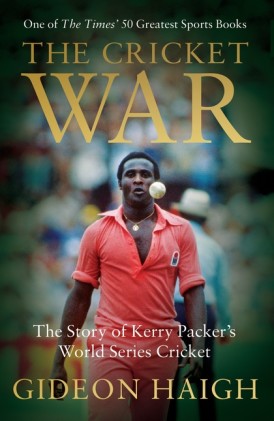The Cricket War
Archie Mac |Published: 2017
Pages: 346
Author: Haigh, Gideon
Publisher: Bloomsbury
Rating: 5 stars

A good book should draw you in from the beginning. Think A Tale of Two Cities “it was the best of times, it was the worst of times” or The Great Gatsby “in my younger and more vulnerable years my father gave me some advice that I’ve being turning over in my head ever since”.
As far as drawing you into a cricket book, The Cricket War has a great hook. The image of the WSC (World Series Cricket) players gathered around a TV in their change rooms following the fortunes of the establishment Australian team is as provocative as it gets. The fact that they are playing their own ‘Super Test’ against the West Indies in a huge but almost empty stadium just adds to the imagery and is a great place for Gideon Haigh to start the WSC story.
The Cricket War was first published in 1993 and author Haigh tells us in his introduction to this 2017 rerelease that he ran into some road blocks in his research. Apparently administrators preferred “that sleeping dogs were best let lie”. Thankfully Haigh was unperturbed and produced arguably the best cricket book yet written. Haigh also tells us in his new introduction that the 2017 version is the first time The Cricket War has been released in the UK.
For those unfamiliar, The Cricket War, is about the WSC schism. Basically the majority of the top Australian players from the 1970s were unhappy about their conditions and pay but attempts to discuss this with those in authority met with the cry that there was no more money. Meanwhile business mogul Kerry Packer was annoyed when the forerunners to Cricket Australia (CA) gave the rights to televise cricket to the Australian Broadcasting Commission (ABC) despite Packer offering substantially more money.
Packer offered the best players in Australia and the world significantly better remuneration and WSC was born. This created a situation where Australia had two national teams. One, WSC, was much stronger than the official team, which was in effect a second XI. Both sides competed for the same fans and dollars. In the end WSC won by an innings and plenty and left the establishment on the brink of bankruptcy.
Haigh puts flesh on the bones of the players involved as well as Packer. Some of the antidotes regarding Packer are amusing, but also give an indication of the power and doggedness of the man. One of Packer’s lines during his WSC negotiations; “There is a little bit of the whore in all of us, gentlemen”, sums up his all or nothing approach to business.
The Cricket War was the first book about WSC to provide the complete story of the Packer years. The only previous books written on the subject were two contemporary accounts, one by Henry Blofeld and the other by the late Peter MacFarlane. Both are quality reads but as WCS was still happening when they were penned, they don’t provide the complete picture of WCS and are firmly anti Packer. Haigh provides the full story from both the establishment and Packer’s side.
Really it’s the combination of some splendid prose, detailed research and the authors’ ability to take you back to the 1970’s that make this a quality read. It should be owned and read by every cricket fan. The Cricket War fully deserves five stars.







Leave a comment